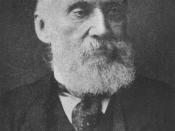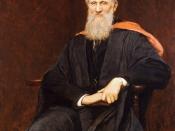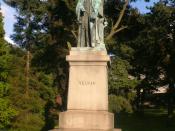LORD KELVIN (1824 - 1907)
William Thomson (later Lord Kelvin) was born June 26, 1824 in Belfast, Ireland, and was part of
a large family whose mother died when he was six. His father taught Kelvin and his brothers mathematics
to a level beyond that of university courses of the time.
Kelvin was somewhat of a genius, and had his first papers published in 1840. These papers
contained an argument defending the work of Fourier (Fourier transforms), which at the time was being
heavily criticized by British scientists. He proved Fourier's theories to be right. In 1839 Kelvin wrote an
essay which he called ' An Essay on the Figure of the Earth.' He used this essay as a source and
inspiration for ideas all his life and won an award from the University of Glasgow in Scotland. Kelvin
remained at the University for the rest of his working life.
Kelvin first defined the absolute temperature scale in 1847, which was later named after him. In
1851 he published the paper, 'On the Dynamical Theory of Heat', and in the same year was elected to the
Royal Society. This work contained his ideas and version of the second law of thermodynamics as well as
James Joule's idea of the mechanical equivalent of heat. This idea claimed that heat and motion were
combined, which now is taken as second nature. At the time, heat was thought to have been a fluid of
some kind.
Kelvin also maintained an interest in the age of the sun and calculated values for it. He assumed
that the sun produced its radiant energy from the gravitational potential of matter falling into the sun. In
collaboration with Hermann von Helmholtz, he calculated and published in 1853 a value of 50 million
years. He also had...


